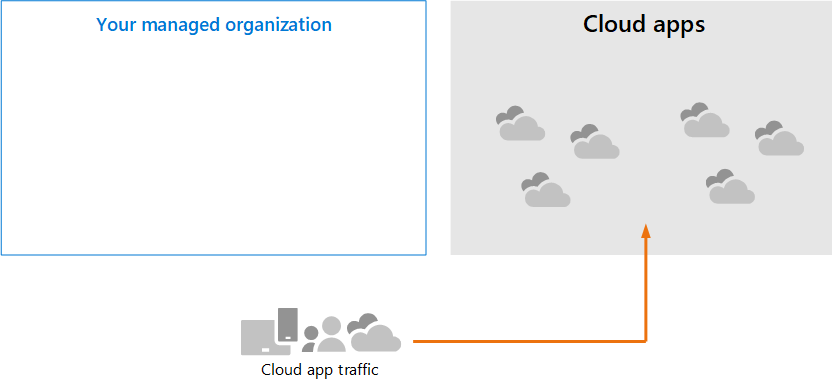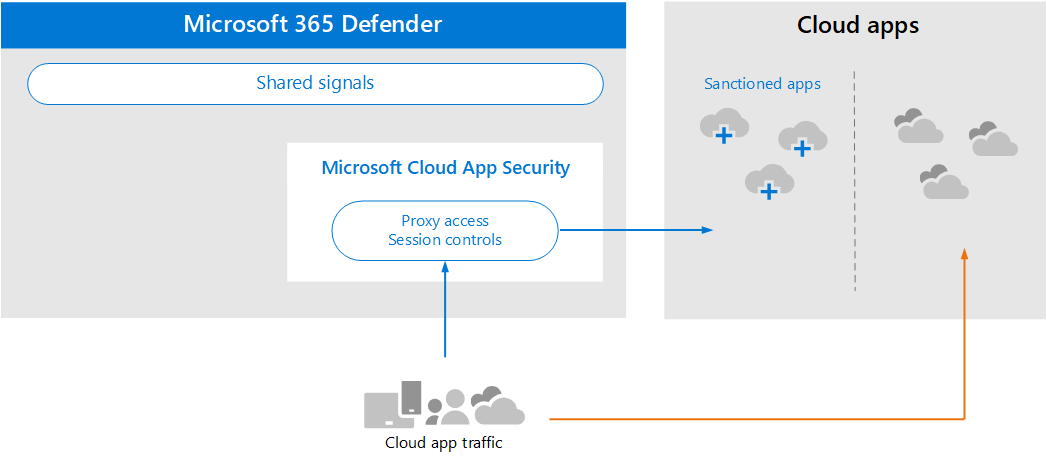Review architecture requirements and key concepts for Microsoft Defender for Cloud Apps
Applies to:
- Microsoft Defender XDR
This article is Step 1 of 3 in the process of setting up the evaluation environment for Microsoft Defender for Cloud Apps alongside Microsoft Defender XDR. For more information about this process, see the overview article.
Before enabling Microsoft Defender for Cloud Apps, be sure you understand the architecture and can meet the requirements.
Understand the architecture
Microsoft Defender for Cloud Apps is a cloud access security broker (CASB). CASBs act a gatekeeper to broker access in real time between your enterprise users and cloud resources they use, wherever your users are located and regardless of the device they are using. Microsoft Defender for Cloud Apps natively integrates with Microsoft security capabilities, including Microsoft Defender XDR.
Without Defender for Cloud Apps, cloud apps that are used by your organization are unmanaged and unprotected, as illustrated.
In the illustration:
- The use of cloud apps by an organization is unmonitored and unprotected.
- This use falls outside the protections achieved within a managed organization.
Discovering cloud apps
The first step to managing the use of cloud apps is to discover which cloud apps are used by your organization. This next diagram illustrates how cloud discovery works with Defender for Cloud Apps.
In this illustration, there are two methods that can be used to monitor network traffic and discover cloud apps that are being used by your organization.
- A. Cloud App Discovery integrates with Microsoft Defender for Endpoint natively. Defender for Endpoint reports cloud apps and services being accessed from IT-managed Windows 10 and Windows 11 devices.
- B. For coverage on all devices connected to a network, the Defender for Cloud Apps log collector is installed on firewalls and other proxies to collect data from endpoints. This data is sent to Defender for Cloud Apps for analysis.
Managing cloud apps
After you discover cloud apps and analyze how these apps are used by your organization, you can begin managing cloud apps that you choose.
In this illustration:
- Some apps are sanctioned for use. This sanction is a simple way of beginning to manage apps.
- You can enable greater visibility and control by connecting apps with app connectors. App connectors use the APIs of app providers.
Applying session controls to cloud apps
Microsoft Defender for Cloud Apps serves as a reverse proxy, providing proxy access to sanctioned cloud apps. This provision allows Defender for Cloud Apps to apply session controls that you configure.
In this illustration:
- Access to sanctioned cloud apps from users and devices in your organization is routed through Defender for Cloud Apps.
- This proxy access allows session controls to be applied.
- Cloud apps that you have not sanctioned or explicitly unsanctioned are not affected.
Session controls allow you to apply parameters to how cloud apps are used by your organization. For example, if your organization is using Salesforce, you can configure a session policy that allows only managed devices to access your organization's data at Salesforce. A simpler example could be configuring a policy to monitor traffic from unmanaged devices so you can analyze the risk of this traffic before applying stricter policies.
Integrating with Microsoft Entra ID with Conditional Access App Control
You might already have SaaS apps added to your Microsoft Entra tenant to enforce multi-factor authentication and other conditional access policies. Microsoft Defender for Cloud Apps natively integrates with Microsoft Entra ID. All you have to do is configure a policy in Microsoft Entra ID to use Conditional Access App Control in Defender for Cloud Apps. This routes network traffic for these managed SaaS apps through Defender for Cloud Apps as a proxy, which allows Defender for Cloud Apps to monitor this traffic and to apply session controls.
In this illustration:
- SaaS apps are integrated with the Microsoft Entra tenant. This integration allows Microsoft Entra ID to enforce conditional access policies, including multi-factor authentication.
- A policy is added to Microsoft Entra ID to direct traffic for SaaS apps to Defender for Cloud Apps. The policy specifies which SaaS apps to apply this policy to. Therefore, after Microsoft Entra ID enforces any conditional access policies that apply to these SaaS apps, Microsoft Entra ID then directs (proxies) the session traffic through Defender for Cloud Apps.
- Defender for Cloud Apps monitors this traffic and applies any session control policies that have been configured by administrators.
You might have discovered and sanctioned cloud apps using Defender for Cloud Apps that have not been added to Microsoft Entra ID. You can take advantage of Conditional Access App Control by adding these cloud apps to your Microsoft Entra tenant and the scope of your conditional access rules.
Protecting your organization from hackers
Defender for Cloud Apps provides powerful protection on its own. However, when combined with the other capabilities of Microsoft Defender XDR, Defender for Cloud Apps provides data into the shared signals which (together) helps stop attacks.
It's worth repeating this illustration from the overview to this Microsoft Defender XDR evaluation and pilot guide.
Focusing on the right side of this illustration, Microsoft Defender for Cloud Apps notices anomalous behavior like impossible-travel, credential access, and unusual download, file share, or mail forwarding activity and reports these behaviors to the security team. Therefore, Defender for Cloud Apps helps prevent lateral movement by hackers and exfiltration of sensitive data. Microsoft 356 Defender for Cloud correlates the signals from all the components to provide the full attack story.
Understand key concepts
The following table identified key concepts that are important to understand when evaluating, configuring, and deploying Microsoft Defender for Cloud Apps.
| Concept | Description | More information |
|---|---|---|
| Defender for Cloud Apps Dashboard | Presents an overview of the most important information about your organization and gives links to deeper investigation. | Working with the dashboard |
| Conditional Access App Control | Reverse proxy architecture that integrates with your Identity Provider (IdP) to give Microsoft Entra Conditional Access policies and selectively enforce session controls. | Protect apps with Microsoft Defender for Cloud Apps Conditional Access App Control |
| Cloud App Catalog | The Cloud App Catalog gives you a full picture against Microsoft catalog of over 16,000 cloud apps that are ranked and scored based on more than 80 risk factors. | Working with App risk scores |
| Cloud Discovery Dashboard | Cloud Discovery analyzes your traffic logs and is designed to give more insight into how cloud apps are being used in your organization as well as give alerts and risk levels. | Working with discovered apps |
| Connected Apps | Defender for Cloud Apps provides end-to-end protection for connected apps using Cloud-to-Cloud integration, API connectors, and real-time access and session controls using our Conditional App Access Controls. | Protecting connected apps |
Review architecture requirements
Discovering cloud apps
To discover cloud apps used in your environment, you can implement one or both of the following methods:
- Get up and running quickly with Cloud Discovery by integrating with Microsoft Defender for Endpoint. This native integration enables you to immediately start collecting data on cloud traffic across your Windows 11 and Windows 10 devices, on and off your network.
- To discover all cloud apps accessed by all devices connected to your network, deploy the Defender for Cloud Apps log collector on your firewalls and other proxies. This deployment helps collect data from your endpoints and sends it to Defender for Cloud Apps for analysis. Defender for Cloud Apps natively integrates with some third-party proxies for even more capabilities.
These options are included in Step 2. Enable the evaluation environment.
Applying Microsoft Entra Conditional Access policies to cloud apps
Conditional Access App Control (the ability to apply Conditional Access policies to cloud apps) requires integration with Microsoft Entra ID. This integration isn't a requirement for getting started with Defender for Cloud Apps. It is a step we encourage you to try out during the pilot phase—Step 3. Pilot Microsoft Defender for Cloud Apps.
SIEM integration
You can integrate Microsoft Defender for Cloud Apps with your generic SIEM server or with Microsoft Sentinel to enable centralized monitoring of alerts and activities from connected apps.
Additionally, Microsoft Sentinel includes a Microsoft Defender for Cloud Apps connector to provide deeper integration with Microsoft Sentinel. This arrangement enables you to not only gain visibility into your cloud apps but to also get sophisticated analytics to identify and combat cyberthreats and to control how your data travels.
- Generic SIEM integration
- Stream alerts and Cloud Discovery logs from Defender for Cloud Apps into Microsoft Sentinel
Next steps
Step 2 of 3: Enable the evaluation environment for Microsoft Defender for Cloud Apps
Return to the overview for Evaluate Microsoft Defender for Cloud Apps
Return to the overview for Evaluate and pilot Microsoft Defender XDR
Tip
Do you want to learn more? Engage with the Microsoft Security community in our Tech Community: Microsoft Defender XDR Tech Community.
Feedback
Coming soon: Throughout 2024 we will be phasing out GitHub Issues as the feedback mechanism for content and replacing it with a new feedback system. For more information see: https://aka.ms/ContentUserFeedback.
Submit and view feedback for





